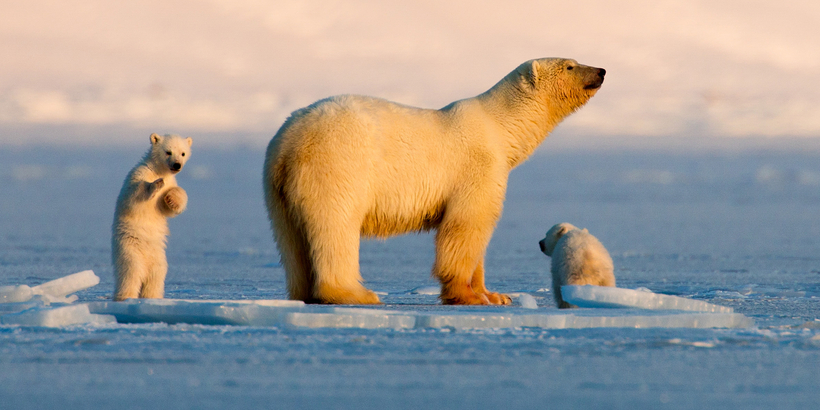If the image of Misha striding through the wilderness of the Arctic Circle seems familiar it is for one of two reasons.
It could be because, unless you are an expert in such matters, one polar bear looks very much like another. Alternatively, it is because Misha is the most photographed polar bear in the world and the unwitting star of documentaries by the world’s leading broadcasters.
Misha, who also goes by the names of Frost and Polar Bear N23992, has appeared in two documentaries for the BBC (Earth’s Greatest Spectacles and Sir David Attenborough’s The Hunt), been patted by Davina McCall while under sedation on ITV (Life at the Extreme) and done turns for National Geographic (Predators) and Netflix (Our Planet). For the last of these, she appeared on a poster with her cub after they had been digitally transposed onto a photograph taken in the Antarctic.
Her image has been manipulated with computer-generated imagery such that a radio collar attached by Norwegian researchers was concealed from viewers of Our Planet.
On the image used to promote the series, a photograph of her has been altered to place her closer to one of her cubs and to replace the backdrop with a dramatic view of a glacier in the Antarctic.
Editing of polar bear footage has caused controversy in the past, such as Sir David Attenborough’s Frozen Planet series in 2011, which seemed to show cubs being born in the wild. Their birth had been filmed in controlled conditions in a Dutch animal park.

Despite her television exposure, Misha’s true and tragic story remained hidden until it was discovered by a geographer from the University of Cambridge. Henry Anderson-Elliott, who visited the bear’s home in the Spitsbergen archipelago while working on his doctorate at the Scott Polar Research Institute, found that Misha did not conform to her public image of a creature isolated in a far-flung wilderness.
Unless you are an expert in such matters, one polar bear looks very much like another.
Jason Roberts, a filmmaker, told Mr Anderson-Elliott that Misha was commonly filmed because she was “a good photo bear” that was “not aggressive, not scared, not worried about you”.
Misha is content to roam round the Tempelfjord inlet despite the tourist traffic that has deterred other bears.
Mr Anderson-Elliott noted that Misha’s tolerance of humans allowed her to prey on seals with little competition from others. “Whether her acclimatization is primarily a result of common human presence in the area or the lengthy periods of time being accompanied by film crews is impossible to tell,” he wrote for the Conversation website.
“She has a tendency to break into cabins in search for food, and astonishingly Roberts even describes how she has learned to use the filmmakers to help her hunt. She observes when seals have been distracted by the cameras and charges them from behind.”
Humans have also been responsible for the death of two of her daughters.
One, nicknamed Lucky, was shot dead after attacking a Czech tourist in his tent. She has since been stuffed, renamed Nina and placed in the lobby of the Oslo department of defense.
Lucky’s sister, nicknamed Light by the filmmaker Asgeir Helgestad, died after scientists from the Norwegian Polar Institute tranquilized her as part of a routine monitoring program.
He told The Times that Frost, as he calls Misha, was “a local bear”, distinct from polar bears that roam widely with no sense of territory.
“What that means is quite complex and following her has been a challenge, especially because of the changing climate conditions,” he said.
“What has been most important for me … was to narrate a true story. Sharing the message of how fragile Frost’s ecosystem and the whole of the natural world have become because of human activity requires persistence and passion for the topic.”

